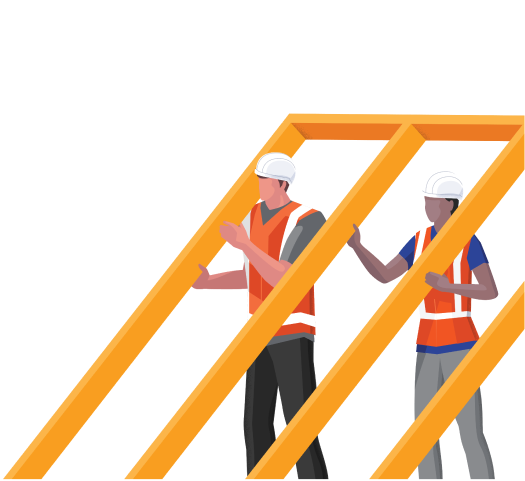— 9 min read
Cultivating & Managing a Healthy Construction Backlog
Last Updated Mar 28, 2024

One of the great challenges for contractors is finding a balance for the right amount of work: They need enough to establish the financial health of their business while not becoming overextended to the point of being unable to deliver quality and timely work. Maintaining a thriving, stable business over a long period of time often comes down to a contractor’s ability to cultivate and manage a healthy and balanced construction backlog.
In this article, we’ll explore the construction backlog: what it is, the importance of keeping a balanced backlog — and best practices for managing and monitoring a backlog to ensure its good health.
Table of contents
What Is Construction Backlog?
To ensure cash keeps flowing, contractors need work lined up beyond what they’re currently doing. The construction backlog refers to the amount of work a contractor has secured but not yet started. Most contractors include a project on their backlog once they become confident they are the contractor for the job, even if a contract hasn’t yet been signed. Projects that are still in a competitive bid stage usually aren’t added.
Backlog is often assessed as an indicator of the financial health and stability of a contractor’s business. A contractor can use their list of upcoming work to help plan, budget, make staffing decisions or inform whether to seek or accept new projects. A contractor’s backlog also helps other people assess the risk of working with them. A backlog may show how in-demand and trusted a contractor is and whether they have the capacity to deliver a project in a timely manner. An insurance or bonding company might use it to determine the risk of investing in them.
Backlog is commonly measured in one of three ways: dollars, time or number of projects. Contractors choose to use different units of measure, depending on who they’re talking to or for what purpose. When speaking to a potential customer, a contractor might express their backlog in terms of weeks or months to convey when they’ll be able to start a new project. For conversations with insurance companies or sureties, a contractor will likely express their backlog in terms of future income to demonstrate their financial stability.
Components of a Balanced Backlog
A balanced, healthy backlog looks different for each contractor and can depend on variables such as company size, specialization, economic trends and location. A million-dollar backlog could be an overwhelming amount of work for one contractor and a disastrously low amount for another. Small contractors might be limited to taking the projects that come their way, while a large company might work to diversify their backlog by taking on different types of projects in different areas.
Considering the unique identity and needs of each contractor, a balanced backlog should represent an amount of work that’s:
- Feasible: A contractor should have the capacity to meet the demands of the work. Projects should only be added to the backlog if they will be able to be completed in a timeframe that works for the owner.
- Profitable and able to cover costs: Contractors have costs associated with doing business or overhead costs. Contractors should have a projection of these costs, so they can compare it to their expected income.
- Aligned with goals and strategy: Both small and large contractor companies often have goals for expanding their businesses, growing their workforces or hitting certain revenue targets. Backlog should align to their goals and communicate to their teams the direction of their strategy
- Able to convey strength and confidence: Potential clients, insurance companies and investors often want to know a contractor is financially stable — in-demand, but also able to fulfill future contracts on time and at a high level of quality.
The Importance of a Well-Balanced Backlog
Finding the right balance for a backlog can be tricky. A backlog that’s too short or non-existent can be a sign that a contractor might be in financial trouble and could soon struggle to cover the overhead costs necessary to stay in business. However, a backlog that’s too extensive can lead to a contractor being overextended and ultimately damaging their reputation in the industry by being unable to deliver projects at a high level of quality and customer satisfaction.
Finding the right balance can create better opportunities for a company and improve a contractor’s work, which can include the following.
- Create a better forecasts for revenue streams.
- Improve the allocation of resources, such as labor, materials and equipment.
- Improve risk management, including lower bond costs and increasing bonding capacity. Insurance companies and sureties often consider backlog when assessing the risk of investing in a contractor.
- Convey financial health by demonstrating guaranteed future income to potential partners, clients and investors.
- Create opportunities to win more competitive bids by demonstrating demand and trustworthiness.
- Increase the ability to be selective in accepting jobs. Having projects on the horizon can free a GC to reject a job that isn’t a good fit or is a low rate.
- Improve reputation by ensuring all projects are completed successfully and on time.
- Increase capacity, by guaranteeing income that can be used to bring on more staff.
Managing and Monitoring Construction Backlog
Construction backlog is generally managed by whoever is in charge of the company’s strategy or financials, which is often the CEO, CFO or, in smaller companies, the owner. Other staff might be involved as well, such as people working on accounting, estimating or bidding.
Some contractors measure backlog as a ratio, comparing the amount of money needed to function and be profitable with the amount of money they expect to make with future projects. This can help attach a timeframe to the financial part of backlog management. For example, a company with $5 million of projects in the pipeline that has average yearly expenses of $10 million knows it can stay in business for at least six months.
The Associated Builders and Contractors (ABC) creates the Construction Backlog Indicator (CBI), which tracks the amount of work that will be performed by commercial and industrial construction contractors in the months ahead and can help contractors compare their backlog to industry standards.
Tracking future projects can help contractors with their own planning and decision-making, communication with stakeholders such as employees and partners, and applying for insurance and bonds. There are a number of tools available to help with this:
- Construction management software: Software can help track every bid and project from preconstruction to closeout. This can help both GCs and subcontractors optimize their backlogs by tracking margins, managing budgets and connecting with different teams working on the same projects.
- Spreadsheets: Some GCs use spreadsheets to track potential future income and compare with expenses. This provides a straightforward assessment of backlog and financial standing but can be challenging for complex projects or managing multiple projects at the same time.
- WIP reports: Work in Progress (WIP) reports are a method of accounting that tracks project costs and revenue. WIPs can include the value and information for upcoming projects and can be shared with potential investors or bonding companies to show financial health. Similarly, the Percentage of Completion Method can help track various projects’ ongoing progress statuses and expenses.
Make it easier to manage construction.

Tips for Managing and Monitoring a Healthy Backlog
While measuring and defining backlog can vary from contractor to contractor, there are a few things that usually help make it easier and more useful.
1. Define a strategy.
The health of a contractor’s backlog should always be measured against their goals and strategy. Large companies often have a formal corporate strategy and detailed reports that can help understand the required amount of work to ensure the company is profitable and growing. Smaller contractors should also have an understanding of their capacity, financials and growth targets so they can assess whether their backlog represents a feasible and profitable amount of work.
2. Adjust communication based on the audience.
Insurance and bonding providers want to hear numbers and financials in order to assess risk. Potential clients want to hear about the timeline for getting to their project. Workers and subcontractors want to know what to expect for their own schedules.
Being able to determine the different ways people refer to backlog can help to meaningfully engage in these conversations and share the information that meet the needs of all stakeholders while avoiding inadvertently giving off the impression of being inexperienced, unreliable or overcapacity.
3. Prioritize project management.
Effective project management helps to maintain realistic deadlines and timelines, which can make a backlog more accurate and easier to manage. Further, many project management tactics and tools help to manage or minimize surprises when contractors are at risk of becoming unorganized or falling behind.
Software that allows the executives to review active project status at a portfolio level can have the most current information on project completion dates to help inform potential start dates for backlog projects.
4. Manage relationships.
Each item on a backlog represents a relationship. It’s a client or owner who hopes to get something out of an interaction or partnership. Part of assessing a backlog is assessing the capacity to nurture these relationships. Reputation is one of the most important things in construction, and it’s built on having the capacity to cultivate and manage relationships with clients.
5. Be realistic about preconstruction work.
Part of preconstruction — and building up a backlog — is the process of estimating and bidding for projects. Most contractors only get a portion of the projects they bid on. Many contractors will track how much time is spent on this work and their average rate for winning bids, which can give an accurate idea of how long it takes to build up a backlog and give information about overhead costs.
Backlog: Taking Control of the Future
Backlogs can help contractors decide to hire more people, take on more projects or make cutbacks when things are lean. A healthy backlog can also help contractors decide how to use their time and resources when variables and delays invariably pop up. However, effectively managing backlog can help change how it feels to work in construction, by shifting jobs in the pipeline from looming anxiety-inducing to-dos to positive indications of a stable, under control and prosperous future.
Categories:
Tags:
Written by
Janine Trinidad
13 articles
Janine Trinidad is a Senior Trainer on the Construction Education team at Procore. In previous roles, Janine managed preconstruction, construction, and turnover on hotel, mixed-use, and institutional projects in the San Francisco Bay area. She was responsible for negotiating contract budgets and change orders, managing RFIs and submittals, and overseeing quality control, among many other project duties. She is also a certified yoga instructor and performance artist. She currently lives in San Diego.
View profileJames Hamilton
29 articles
James Hamilton is a writer based in Brooklyn, New York with experience in television, documentaries, journalism, comedy, and podcasts. His work has been featured on VICE TV and on The Moth. James was a writer and narrator for the show, VICE News Tonight, where he won an Emmy Award and was nominated for a Peabody Award.
View profileWin More Work
Get discovered for relevant work on the Procore Construction Network.

Explore more helpful resources

Contract Precedence: A Clause to Clear Construction Confusion
Construction contracts are usually lengthy and complicated, composed of a wide range of documents In a perfect world, the contract provides the clarity and direction all stakeholders need to move...

A Contractor’s Guide to Working With Construction Union Labor
In the construction industry, unions play a critical role, bringing together laborers and tradespeople such as plumbers, carpenters or masons under collective bargaining agreements with employers. These agreements set the...

Jobsite Security: Assessing and Minimizing Construction Site Risks
Assessing security needs for a construction site early can save time and money and avert potential complications later on the project. Security on a jobsite mitigates risks by protecting the area...

Understanding As-Built Drawings in Construction
At the end of a construction project, owners want to feel confident that all work was completed to their satisfaction and that they are set up to assume control of...
